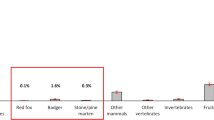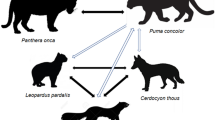Abstract
Mesocarnivores face interspecific competition and risk intraguild predation when sharing resources with apex carnivores. Within a landscape, carnivores across trophic levels may use the same communication hubs, which provide a mix of risks (injury/death) and rewards (gaining information) for subordinate species. We predicted that mesocarnivores would employ different strategies to avoid apex carnivores at shared communication hubs, depending on their trophic position. To test our prediction, we examined how different subordinate carnivore species in the Santa Cruz Mountains of California, USA, manage spatial overlap with pumas (Puma concolor), both at communication hubs and across a landscape-level camera trap array. We estimated species-specific occurrence, visitation rates, temporal overlap, and Avoidance–Attraction Ratios from camera traps and tested for differences between the two types of sites. We found that mesocarnivores generally avoided pumas at communication hubs, and this became more pronounced when pumas scent-marked during their most recent visit. Coyotes (Canis latrans), the pumas’ closest subordinate competitor in our system, exhibited the strongest avoidance at communication hubs. Gray foxes (Urocyon cinereoargenteus) avoided pumas the least, which may suggest possible benefits from pumas suppressing coyotes. Overall, mesocarnivores exhibited various spatiotemporal avoidance strategies at communication hubs rather than outright avoidance, likely because they benefit from information gained while ‘eavesdropping’ on puma activity. Variability in avoidance strategies may be due to differential predation risks, as apex carnivores often interact more aggressively with their closest competitors. Combined, our results show how apex carnivores trigger complex species interactions across the entire carnivore guild and how trophic position determines behavioral responses and subsequent space use of subordinate mesocarnivores across the landscape.


Similar content being viewed by others
Data availability
Data will be made available by authors for any reasonable request.
Code availability
Not applicable.
References
Allen ML, Wittmer HU, Wilmers CC (2014) Puma scrape and communication behaviors: understanding functional use and variation by sex and age. Behav 151:819–840
Allen ML, Elbroch LM, Wilmers CC, Wittmer HU (2015a) The comparative effects of large carnivores on the acquisition of carrion by scavengers. Am Nat 185:822–833
Allen ML, Wallace CF, Wilmers CC (2015b) Patterns in bobcat (Lynx rufus) scent marking and communication behaviors. J Ethol 33:9–14
Allen ML, Wilmers CC, Elbroch LM, Golla JM, Wittmer HU (2016) The importance of motivation, weapons and foul odors in driving encounter competition in carnivores. Ecology 97:1905–1912
Allen ML, Gunther MS, Wilmers CC (2017) The scent of your enemy is my friend? The acquisition of large carnivore scent by a smaller carnivore. J Ethol 35:13–19
Apps P, Rafiq K, McNutt JW (2019) Do carnivores have a world wide web of interspecific scent signals? In Chemical signals in vertebrates, vol 14. Springer, Cham, pp 182–202
Brown JS, Laundre JW, Gurung M (1999) The ecology of fear: optimal foraging, game theory, and trophic interactions. J Mammal 80:385–399
Burton AC, Neilson E, Moreira D, Ladle A, Steenweg R, Fisher JT, Bayne E, Boutin S (2015) Wildlife camera trapping: a review and recommendations for linking surveys to ecological processes. J Appl Ecol 52(3):675–685
Cornhill KL, Kerley GI (2020a) Cheetah behaviour at scent-marking sites indicates differential use by sex and social rank. Ethology 126:976–986
Cornhill KL, Kerley GI (2020b) Cheetah communication at scent-marking sites can be inhibited or delayed by predators. Behav Ecol Sociobiol 74:1–10
Davis CL, Rich LN, Farris ZJ, Kelly MJ, Di Bitetti MS, Blanco YD, Albanesi S, Farhadinia MS, Gholikhani N, Hamel S, Harmsen BJ (2018) Ecological correlates of the spatial co-occurrence of sympatric mammalian carnivores worldwide. Ecol Let 21:1401–1412
Donadio E, Buskirk SW (2006) Diet, morphology, and interspecific killing in carnivora. Am Nat 167:524–536
Elbroch LM, Wittmer HU (2012) Table scraps: inter-trophic food provisioning by pumas. Biol Let 8:776–779
Estes JA, Terborgh J, Brashares JS, Power ME, Berger J, Bond WJ, Carpenter SR, Essington TE, Holt RD, Jackson JBC, Marquis RJ, Oksanen L, Oksanen T, Paine RT, Pikitch EK, Ripple WJ, Sandin SA, Scheffer M, Schoener TW, Shurin JB, Sinclair ARE, Soule ME, Virtanen R, Wardle DA (2011) Trophic downgrading of planet earth. Science 333:301–306
Finnegan SP, Gantchoff MG, Hill JE, Siveira L, Torres NM, Jacomo AT, Uzal A (2021) “When the felid’s away, the mesocarnivores will play”: seasonal temporal segregation in a neotropic carnivore guild. Mammal Biol 101:631–638
Garvey PM, Glen AS, Pech RP (2016) Dominant predator odour triggers caution and eavesdropping behavior in a mammalian mesopredator. Behav Ecol Sociobiol 70:481–492
Harmsen BJ, Foster RJ, Gutierrez SM, Marin SY, Doncaster CP (2010) Scrape-marking behavior of jaguars (Panthera onca) and pumas (Puma concolor). J Mammal 91:1225–1234
Hughes NK, Price CJ, Banks PB (2010) Predators are attracted to the olfactory signals of prey. PLoS ONE 5:e13114
Jackson K, Wilmers CC, Wittmer HU, Allen ML (2021) First documentation of scent marking behaviors in striped skunks (Mephitis mephitis). Mammal Res 66:399–404
Krofel M, Hocevar L, Allen ML (2017) Does human infrastructure shape scent marking in a solitary felid? Mammal Biol 87:36–39
Levi T, Wilmers CC (2012) Wolves–coyotes–foxes: a cascade among carnivores. Ecol 93:921–929
Li J, Schaller GB, McCarthy TM, Wang D, Jiagong Z, Cai P, Basang L, Lu Z (2013) A communal sign post of snow leopards (Panthera uncia) and other species on the Tibetan Plateau. China Int J Biodiv 2013:370905
Meredith M, Ridout M (2014) Overlap: estimates of coefficient of overlapping for animal activity patterns R package version 0.2.3. http://CRAN.R-project.org/package=overlap; http://CRAN.R-project.org/package=overlap
Moller AP, Christiansen SS, Mousseau TA (2011) Sexual signals, risk of predation and escape behavior. Behav Ecol 22:800–807
Murphy K, Ruth TK (2009) Diet and prey selection of a perfect predator. In: Hornocker M, Negri S (eds) Cougar: ecology and conservation. University of Chicago Press, Chicago, Illinois, pp 118–137
Newsome TM, Ripple WJ (2015) A continental scale trophic cascade from wolves through coyotes to foxes. J Anim Ecol 84:49–59
O’Connell AF, Nichols JD, Karanth KU (2011) Camera traps in animal ecology: methods and analyses, vol 271. Springer, New York
Parsons AW, Bland C, Forrester T, Baker-Whatton MC, Schuttler SG, McShea WJ, Costello R, Kays R (2016) The ecological impact of humans and dogs on wildlife in protected areas in eastern North America. Biol Conserv 203:75–88
Prugh LR, Sivy KJ (2020) Enemies with benefits: integrating positive and negative interactions among terrestrial carnivores. Ecol Let 23:902–918
Prugh LR, Cunningham CX, Windell RM, Kertson BN, Ganz TR, Walker SL, Wirsing AJ (2023) Fear of large carnivores amplifies human-caused mortality for mesopredators. Science 380:754–758
Rafiq K, Jordan NR, Meloro C, Wilson AM, Hayward MW, Wich SA, McNutt JW (2020) Scent-marking strategies of a solitary carnivore: boundary and road scent marking in the leopard. Anim Behav 161:115–126
Ridout MS, Linkie M (2009) Estimating overlap of daily activity patterns from camera trap data. J Agr Biol Environ Stat 14:322–337
Ripple WJ, Estes JA, Beschta RL, Wilmers CC, Ritchie EG, Hebblewhite M, Berger J, Elmhagen B, Letnic M, Nelson MP, Schmitz OJ, Smith DW, Wallach AD, Wirsing AJ (2014) Status and ecological effects of the world’s largest carnivores. Science 343:1241484
Rowcliffe M (2021) Activity: animal activity statistics. CRAN
Sikes RS, Gannon WL, the Animal Care and Use Committee of the American Society of Mammalogists (2011) Guidelines of the American Society of Mammalogists for the use of wild mammals in research. J Mammal 92:235–253
Sivy KJ, Pozzanghera CB, Grace JB, Prugh LR (2017) Fatal attraction? Intraguild facilitation and suppression among predators. Am Nat 190:663–679
Smith JLD, McDougal C, Miquelle D (1989) Scent marking in free–ranging tigers, Panthera tigris. Anim Behav 37:1–10
Wang Y, Allen ML, Wilmers CC (2015) Mesopredator spatial and temporal responses to large predators and human development in the Santa Cruz Mountains of California. Biol Conserv 190:23–33
Wikenros C, Jarnemo A, Frisén M, Kuijper DP, Schmidt K (2017) Mesopredator behavioral response to olfactory signals of an apex predator. J Ethol 35:161–168
Wilmers CC, Wang Y, Nickel B, Houghtaling P, Shakeri Y, Allen ML, Kermish-Wells J, Yovovich V, Williams T (2013) Scale dependent behavioral responses to human development by a large predator, the puma. PLoS ONE 8:e60590
Yovovich V, Allen ML, Macaulay LT, Wilmers CC (2020) Using spatial characteristics of apex carnivore communication and reproductive behaviors to predict responses to future human development. Biodiv Conserv 29:2589–2603
Acknowledgements
The authors would like to thank the Mid-Peninsula Open Space District, California State Parks, Santa Cruz Land Trust, Santa Clara Parks, San Mateo Parks, and many private landowners for giving us access to their land. The authors thank P. Houghtaling, R. King, C. Fust, S. McCain, and many others for their contributions to the fieldwork.
Funding
Funding was provided by National Science Foundation under Grant Nos. #0963022 and #1255913 and the Gordon and Betty Moore Foundation.
Author information
Authors and Affiliations
Contributions
MLA and CCW conceived and designed the experiments. MLA performed the fieldwork and annotated images. ACA and MLA analyzed the data. MLA wrote the manuscript, and all other authors provided editorial advice.
Corresponding author
Ethics declarations
Conflict of interest
The authors declare that they have no conflict of interest.
Ethical approval
All field experimental procedures were performed within the guidelines set by the Independent Animal Care and Use Committee at the University of California, Santa Cruz (Protocols Wilmc0709 and Wilmc1101) and the American Society of Mammalogists (Sikes et al. 2011).
Consent to participate
Not applicable.
Consent for publication
Not applicable.
Additional information
Communicated by Michael Sheriff .
Rights and permissions
Springer Nature or its licensor (e.g. a society or other partner) holds exclusive rights to this article under a publishing agreement with the author(s) or other rightsholder(s); author self-archiving of the accepted manuscript version of this article is solely governed by the terms of such publishing agreement and applicable law.
About this article
Cite this article
Allen, M.L., Avrin, A.C., Wittmer, H.U. et al. Mesocarnivores vary in their spatiotemporal avoidance strategies at communications hubs of an apex carnivore. Oecologia (2024). https://doi.org/10.1007/s00442-024-05541-y
Received:
Accepted:
Published:
DOI: https://doi.org/10.1007/s00442-024-05541-y




